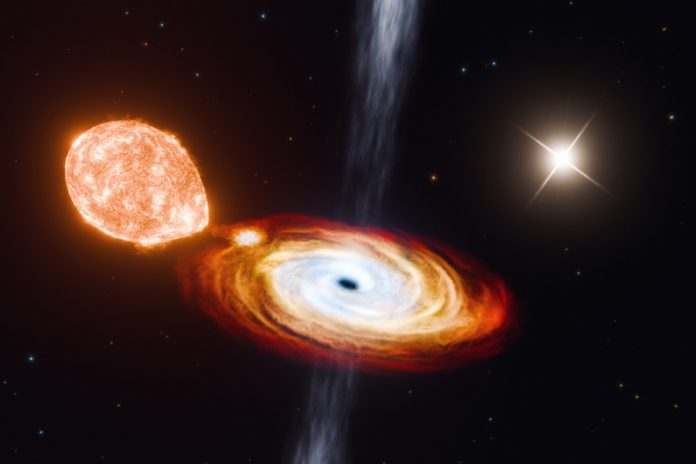
Physicists at MIT and Caltech have made an unexpected discovery—a “black hole triple” system, the first of its kind ever found.
While most black holes detected so far are part of a pair, or binary system, this new system consists of three objects: a central black hole, a small star closely orbiting it, and a second star much farther away.
The inner star is in a tight orbit, circling the black hole every 6.5 days, while the distant star takes around 70,000 years to complete one orbit.
This triple system, named V404 Cygni, raises questions about how black holes are formed.
Typically, black holes are thought to emerge from the violent explosion of a dying star, known as a supernova.
This massive event usually releases so much energy that it would push away any loosely bound objects, making it unlikely for distant stars to remain in orbit.
However, the presence of this far-off star suggests a different story.
The researchers propose that the black hole in V404 Cygni likely formed through a “direct collapse,” where a star collapses inward without a dramatic explosion.
This gentle collapse would allow the outer star to remain in its orbit, held loosely by the black hole’s gravity.
Lead author Kevin Burdge from MIT says, “We think most black holes form from violent explosions of stars, but this discovery challenges that idea. This system is super exciting for black hole evolution, and it also raises questions of whether there are more triples out there.”
The discovery happened almost by accident while researchers were exploring images of V404 Cygni using an online tool called Aladin Lite, which compiles observations from telescopes worldwide.
When Burdge and his team looked closely at these images, they noticed two separate sources of light.
The first source came from the known black hole and its closely orbiting star, but the second source seemed to come from a much farther star.
To confirm if the distant star was linked to the black hole, the team analyzed data from the Gaia satellite, which tracks star movements.
They discovered that both stars were moving in sync, making it highly unlikely to be a coincidence. The distance between the two stars is immense, around 3,500 times the distance between Earth and the Sun.
By running thousands of simulations, the researchers concluded that the most plausible way for this triple system to exist is through direct collapse. The distant star also helped the researchers estimate the system’s age to be around 4 billion years old.
This discovery not only challenges our understanding of how black holes form but also hints at the existence of more such triple systems in the universe.
Source: MIT.



